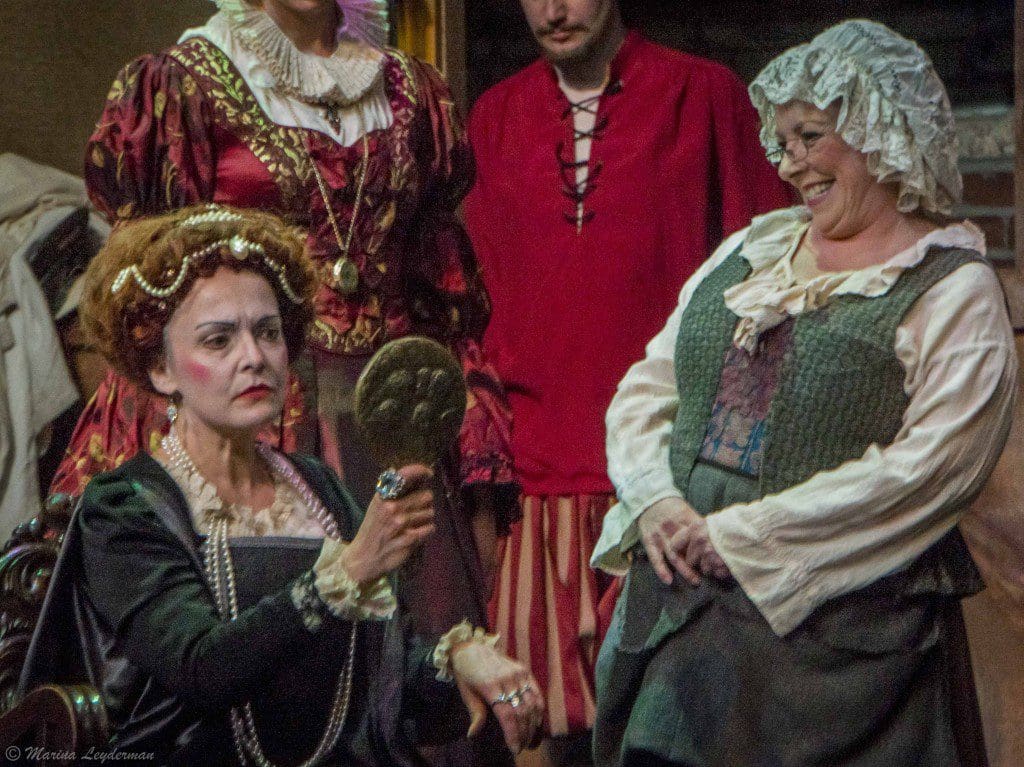Before we announce the winners of the 2014 My Theatre Awards, we’re proud to present our annual Nominee Interview Series.
Queen Elizabeth I in Timothy Findley’s gorgeous historical fiction Elizabeth Rex is a gift of a dramatic role for any actress. For relative newcomer Lydia Kiselyk, the chance to play the part in the East Side Players’ 2014 production was monumental. With her co-star Michael Harvey, Lydia is one of only two nominees to come out of community theatre this year, having given a startling Best Actress nomination-worthy performance that put her squarely in competition with the pros.
Can you remember your first experience with theatre?
My first experience with theatre was in high school. I played Ruth, a brash but bewildered adolescent girl who had epilepsy, in Paul Zindel’s The Effect of Gamma Rays on Man-in-the-Moon Marigolds. I remember throwing fits, sneaking cigarettes and handling a live rabbit on stage. But most of all, I remember the excitement of rehearsing in the auditorium after school in the dark under the stage lights – of living inside a character and creating a reality different from the one just outside the auditorium doors.
Where did you develop as an actor?
I have not had any formal training as an actor. I worked for the Standardized Patient Program at the University of Toronto for a number of years where, for the purpose of helping to teach interviewing skills to medical students, I role-played a multitude of patients presenting with a variety of physical and psychological issues. We were given background information about the patients’ presenting problems along with their personality characteristics and personal, family, social and medical history, and then improvised with this information while being interviewed by medical students. I also performed with the Arte Flamenco Spanish Dance Company for about ten years and participated in flamenco theatrical productions such as Medea and El Amor Brujo. We also collaborated in the Spanish productions of other musical theatre companies, such as Toronto Operetta Theatre and Summer Opera Lyric Theatre. My involvement in community theatre has been a relatively recent development over the past three years.
Do you have any dream projects?
I don’t have any dream projects per se, but an objective to participate in as many different kinds of plays as possible at this point in order to develop my range and experience as an actor.
What’s your favourite production you’ve ever worked on?
I do have to say that Elizabeth Rex has been my favourite production to date. Being relatively new to the community theatre scene, it is only the fourth production in which I have performed, and by far the most challenging and rewarding. A great script, and a talented and dedicated director and cast made for a thrilling learning experience for me and set the standard that much higher for the expectations that I have of myself as a developing actor.
How did you get involved with East Side Players?
Ever since I made the decision to try my hand at community theatre I have been looking out for the audition notices posted by various community theatres in the city, and East Side Players just happened to be one of them who responded favourably to my auditions. Their aim is to have at least one challenging production per season – challenging for actors and audiences alike – and I look for challenges.
How much research did you do to prepare to play Queen Elizabeth I? How much of your performance was a historical representation and how much an interpretation like you might do of an entirely fictional character?
The director did intensive table work with the actors playing the main characters. This involved a thorough line-by-line discussion of meaning and intention, informed by historical context as well as the play’s main themes of personal identity and integrity. We analyzed important passages in the play in this manner and were encouraged to continue this kind of analysis on our own for any passages not covered in group discussions.
Additionally, I combed the websites dedicated to Elizabethan political, religious and cultural history, and focused particularly on those sites that referred to Elizabeth I’s personal history, her relationships with people such as Essex, Cecil, Shakespeare, her personality and pastimes, etc. I even learned to dance a simple gaillard, which was reportedly one of her favourite dances that she also used as a form of daily exercise.
My performance of Elizabeth I however, was a combination of both historical representation of actual figure and interpretation of fictional character, with the weight being placed on interpretation rather than representation. The historical research was necessary because I was playing a well-recognized historical figure. What was most potent to me however, was the personal element of an individual struggling with the conflicting demands between her personal life as woman and professional life as monarch.
What was the most important conversation you had with your director in developing your performance?
It was not so much a conversation as a single statement. In the midst of others giving me references to great actresses who had taken on the part of Elizabeth I, my director shook her head and said that I had to make her my own – I took that to mean that Elizabeth I was not only a monarch but a woman and that I had to find that personal element for myself to make her real.
 How important were the costume, wig and makeup to your performance?
How important were the costume, wig and makeup to your performance?
They were the finishing touch to a lot of background work – icing on the cake, almost literally. In rehearsals, I tried not to wear anything that would make me feel like a queen despite our hair and makeup consultant suggesting that I wear a rehearsal wig. I figured that if I couldn’t come across as a monarch in my street clothes then I wasn’t working hard enough at finding her within me. I was also more interested in finding that personal connection to Elizabeth I as a woman. Having said that however, it was quite apparent that the costume, wig and makeup made me carry myself differently when I finally used them in dress rehearsals. Just before I stepped onto the stage for every performance, I took a last look at myself in the mirror to take in the fact that I was indeed the Queen for the evening. I also took a turn about backstage to feel the costume’s effect on me so that when I walked onto the stage it was most definitely as Elizabeth I, the Queen.
Your relationship with Michael Harvey’s Ned was the centrepiece of the show. Tell us a bit about developing that relationship.
Ironically, apart from the intensive table work with the main characters mentioned above, Michael and I did little work together apart from having casual conversations on the subway to and from rehearsals. The relationship evolved out of each of us working on our respective character’s motivations and issues, and then bringing them to bear on each other in rehearsals. It is such a well-written script that the point-counterpoint interactions of Elizabeth and Ned fell into place quite naturally.
If Elizabeth I were to see a production of Elizabeth Rex, what do you think she would say about Timothy Findley’s imagining of her?
As a monarch, Elizabeth I might be tempted to send Findley to the Tower for all of the improbability and irreverence of depicting her spending the night in a barn, socializing with Shakespeare’s troupe of actors, and allowing herself to be disrespectfully challenged by his lead actor. As an intelligent, perceptive and witty woman, scholar and patron of the arts, especially of theatre, I think she would see through this device as a method of externalizing, and actually compassionately rendering, the struggle she faced as a woman in her time having begrudgingly taken on the role of monarch as a duty to her country that she expected herself to discharge faithfully above all else.
Do you have a favourite moment in the production?
My favourite moment I call the point of no return – when Essex’s letter doesn’t contain the hoped-for request for pardon and when Elizabeth I realizes that there is not enough time left for her to intervene in his execution or at least to say goodbye – that is, when Elizabeth breaks open as a woman for a very short while before she closes up again into her role as monarch.
What are you doing now/ what’s your next project?
I’m currently performing in Andrew Bovell’s Speaking in Tongues with East Side Players at The Papermill Theatre. It’s a challenging ensemble piece for four actors who play a total of nine characters in overlapping dialogues and interweaving monologues. There are no new projects on the horizon but I am thinking about taking a workshop on voice and body work.
Do you have anything you’d like to add?
I was really touched by your review of my performance in Elizabeth Rex. It was quite validating to have put so much work into a character and then to have that work acknowledged. To further hear that I got nominated was something I certainly had not expected and for which I am quite honoured. Thank you.

